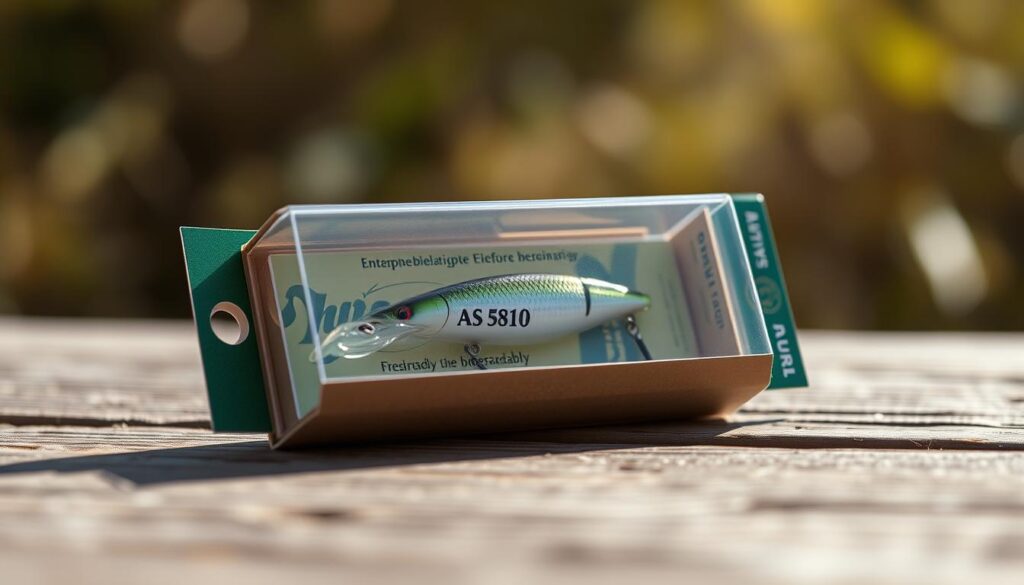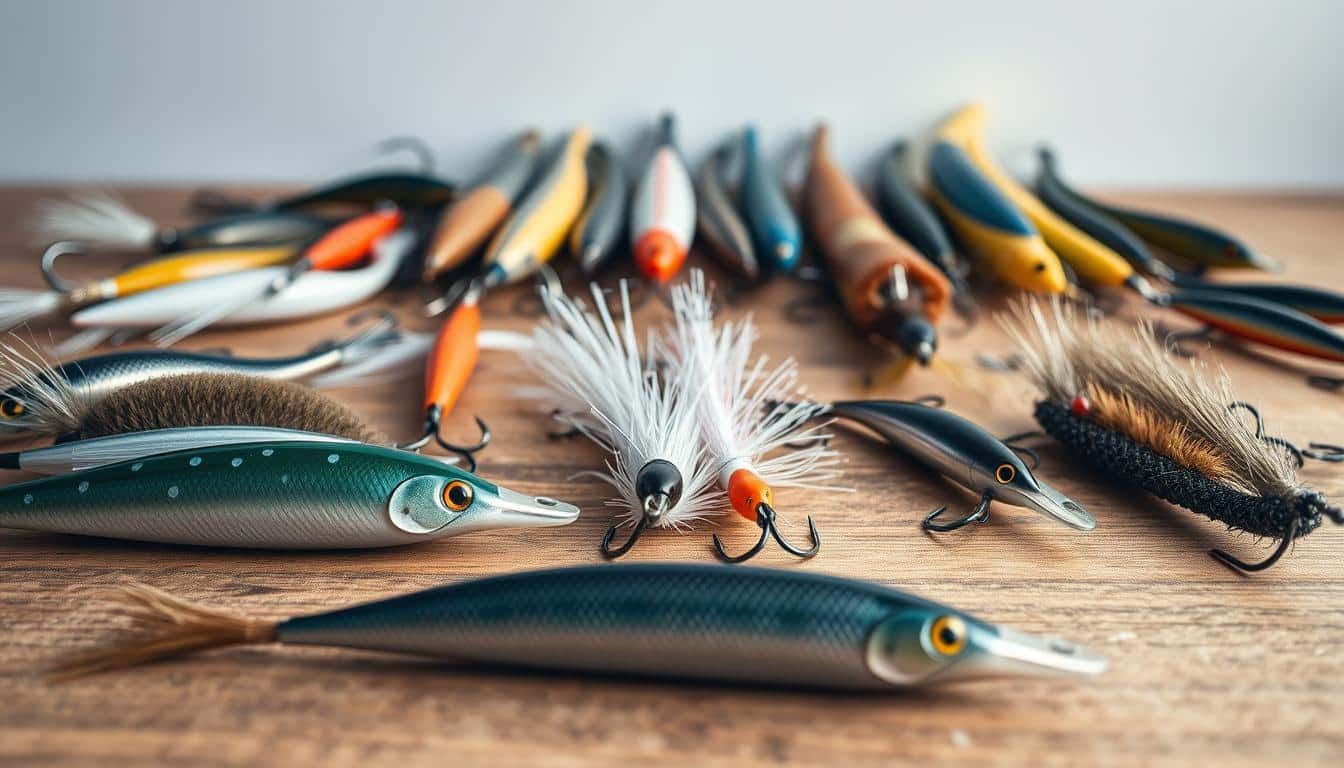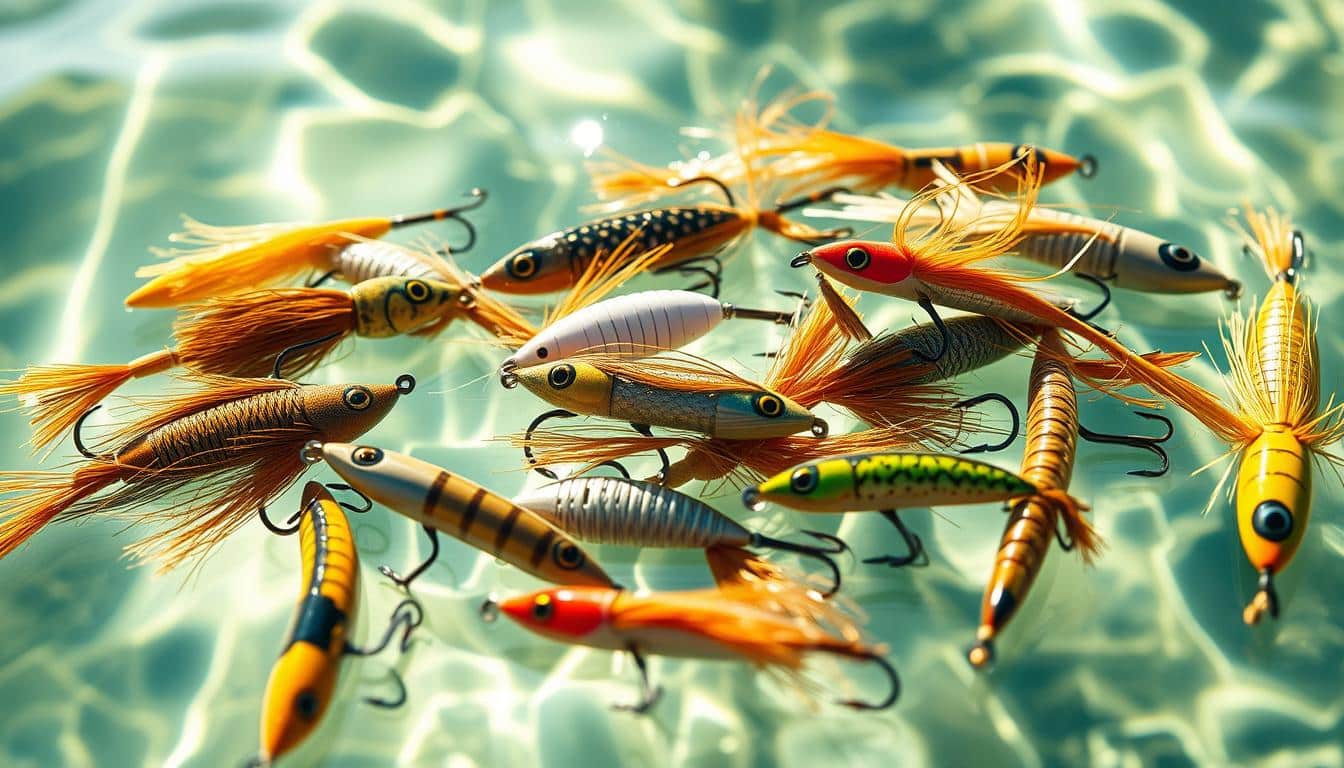Fishers in the U.S. are updating their tackle boxes with help from brands like StormX. They’re choosing earth-friendly fishing lures over traditional ones. These lures don’t use oil-based plastics, yet they work just as well. Many anglers find that using biodegradable baits helps protect our waters. And they don’t have to give up catching their favorite fish.
One leading maker stopped taking orders to improve their biodegradable lure with experts’ help. This shows their dedication to creating the top eco-friendly fishing lure. They are working with scientists who care about the environment. Also, new smart packaging shows that green fishing in the U.S. can be good for the planet and great for fishing.
Companies are reaching out to customers directly. They send fishing tips, eco-news, and product updates in monthly newsletters. This helps angler communities learn the right way to use and throw away these lures. It keeps them up to date on the newest green fishing products, too.
Why switch to soft plastic-free lures for sustainable angling
Anglers are changing their tackle boxes for the better. By choosing non-traditional lures, they’re cleaning up our beaches. This also helps cut down on pollution that affects fish and birds.
Softbait packaging is often not eco-friendly. It usually includes heavy plastics and can weigh a lot. When millions are sold, the waste adds up fast.
Environmental impacts of traditional soft plastics
Lost fishing gear doesn’t just disappear. It ends up on beaches, breaking down into tiny harmful pieces. These microplastics are eaten by sea life, causing problems in our oceans.
The layers and glues in softbait packs make recycling tough. So, most of these packages end up polluting our coastlines for a long time.
Benefits for fisheries and coastal ecosystems
Less pollution means safer waters for young fish and birds. This leads to better places for them to live and grow. Good for both sport fishing and nature.
Making better choices in lures and packages helps a lot. It’s like cutting millions of plastic bottles from our waste each year. This means fewer microplastics in our water and food.
Angler responsibility and conservation culture
Anglers choosing eco-friendly gear are leading by example. Picking products that don’t harm the environment supports responsible companies. This helps our oceans and rivers.
- Pick baits with compostable or minimal packaging.
- Return or properly dispose of damaged packs and inserts.
- Share best practices to promote sustainable fishing behavior among peers.
Every small step from anglers prompts big changes. When we ask for better products, companies listen. They then create items that significantly reduce waste and pollution.
Materials and technologies behind plastic-free soft baits
Designing soft plastic-free baits requires a mix of chemistry, new packaging ideas, and real-world testing. Companies collaborate with biopolymer experts to change formulas. This ensures fishermen feel and see the expected performance. Taking time to adjust flexibility, smell, and how long they last is part of making them as good as traditional softbaits.
Biopolymers and home-compostable materials
- Brands are choosing compostable polymers like PLA and certified blends for their products.
- Certifications from AS 5810, DIN CERTCO, and TÜV Austria assure these materials decompose safely at home.
- Working with experts makes sure these fishing lures are both easy to make and will break down after use.
Plant-based clamshells and presentation solutions
- Companies are now using plant-based clamshells instead of plastic trays to package soft baits.
- These eco-friendly inserts keep baits in shape while being shipped and can be composted at their lifecycle’s end.
- New packaging combines compostable PLA polymers with fiber or starch-based trays, making everything renewable.
Performance engineering: scent, flexibility, and durability
- Manufacturers are making scent carriers that fit non-oil materials, ensuring the smells last.
- The goal is to make them super flexible yet strong enough to use many times, offering fishermen consistent success.
- Lab and real-life testing are essential to confirm these biopolymer lures meet everyone’s expectations before they’re widely made.
Soft Plastic-Free Lures for Sustainable Angling
Anglers and retailers need to understand what switching products means. “Soft plastic-free lures” refer to baits and packaging not made from petroleum-based plastics. They’re designed to decompose in home or certified compost setups. Brands should provide clear labels, certification details, and end-of-life guidelines.
What the phrase means for anglers and retailers
For anglers, these lures help cut down on water pollution and microplastic build-up. Retailers see it as a call to offer sustainable bait options, highlighting certifications, shelf life, and usage. Brands must be transparent, reformulating with biopolymer experts if needed. This shows they care about product quality and environmental impact.
Examples of product features to expect
- Clear compostable lure features: AS 5810, DIN CERTCO, or TÜV Austria certifications on packaging and product inserts.
- Non-toxic scent carriers and renewable binders that preserve flexibility and bait action without petroleum ingredients.
- Plant-based clamshells or home-compostable pouches with printed end-of-life instructions for consumers and retailers.
- Performance notes from brands about durability in saltwater, recommended storage, and scent refresh cycles to match traditional softbaits.
When shopping, insist on having eco-friendly tackle but always ask for proof. Guides on sustainable lures should show test outcomes, composting times, and how to dispose of products correctly. This ensures anglers know what to do after using the products.
Top soft plastic-free lure brands and emerging products
The demand for eco-friendly fishing gear is rapidly increasing. Fishers and sellers keep an eye on new products to find meaningful advances. Some well-known companies are even stopping their current production. They do this to work with biopolymer partners. This shows they favor quality over just looking eco-friendly without real action.
Notable product launches and brand initiatives
One product to watch is StormX compostable bait from Wise Angler. It’s not out yet, but people are already excited about it. It promises eco-friendly packaging, plant-based materials, and top-notch performance.
Other green lure makers are teaming up with experts to improve their products. They aim to make lures that last longer, flex well, and keep their smell. Look out for new eco-friendly tackles that are tested by third parties and come with clear recycling info.
How to evaluate brand claims
Checking a brand’s eco-friendly claims? Look for official eco-certifications like AS 5810 or TÜV Austria. But don’t just rely on the logos. Always search for independent test results and how to properly dispose of the product.
- Read real reviews to learn how well the gear works in nature.
- See what the brand says about their research on the product’s strength and smell.
- Sign up for updates to keep track of new trials and product availability.
Be mindful of how brands talk about their eco-friendly products. Real commitment shows in lab results, clear composting details, and honest timelines. This is more reliable than broad and unclear eco-friendly claims.
How to choose the right plastic-free lures for your fishing style
Choosing the right plastic-free lure is easy. Think about your fishing spot, target fish, and bait storage. This guide helps you pick compostable lures that work great without harming the environment.
Freshwater versus saltwater considerations
Saltwater fishing needs tougher materials. The ocean’s conditions require lures that can handle abrasion and salt. For trips near the coast or out at sea, find biopolymer lures designed for saltwater.
In lakes and rivers, softer lures work best for catching bass and trout. When picking lures for freshwater, compare how they sink and bend.
Target species and lure profiles
Choose lures based on fish behavior. Bass like larger, scented baits. A good bass lure made of compostable material should keep its scent and shape after many uses.
Trout and panfish enjoy lures that move gently and are presented lightly. Redfish and snook, caught near shores, prefer baits that can handle currents and obstacles. Consider softness, movement, and how well the lure holds its scent.
Handling and storage tips for compostable baits
Storing your baits right can make them last longer. Keep them cool, dry, and out of the sun. Humidity can ruin the packaging and the baits.
When traveling, protect your baits in rigid plant-based boxes or sealable bags. To keep partially used baits in good shape, dry them and lay them flat.
- Inspect packaging claims and R&D notes from brands working with biopolymer experts.
- Test a few sizes and scents before committing to a full supply.
- Subscribe to brand newsletters for real-world storage tips and user reports.
By considering these points, you find a balance between good performance and being eco-friendly. Look carefully at specs for saltwater compostable baits and tips for storing them to ensure success while fishing.
Packaging, end-of-life, and responsible disposal
Anglers have choices when packaging ends its life. Clear labels and certifications guide these choices. Look for third-party marks that confirm a product can decompose in a compost pile instead of lasting forever in a landfill.

Understanding compostable certifications and home composting
Certifications like AS 5810, DIN CERTCO, and TÜV Austria show that some bait packs can be composted at home. These standards test materials in real household composts so anglers can rely on the outcomes.
If a pack has one of these marks, you can compost bait packs by following the maker’s directions. First, remove any metal hooks. Rinse off any thick oil. Then, cut or shred the pack to help it break down faster.
Why traditional recycling won’t work for most softbait packs
Most softbait packs can’t be recycled easily. They have many layers, sticky glues, scent oils, and leftover bait. Sorting machines can’t handle small clamshells and dirty pouches well. So, recycling isn’t a good solution for many anglers.
Special drop-off spots for soft plastics often say no to dirty items. If recycling doesn’t work, these packs might end up in landfills or float into rivers and oceans.
Best disposal practices for anglers
- Compost certified materials at home or through community programs to safely get rid of compostable lures.
- Use retailer return or manufacturer take-back programs instead of putting items in your recycling bin.
- Choose refillable clamshells or buy in bulk to use less packaging.
- Always take your fishing trash off the shore and your boat to protect the water.
- Sign up for updates from fishing brands and local compost services to know where to recycle fishing packaging and find take-back events.
By following these guidelines, anglers can lessen pollution and help recycle better. Even small steps near the water can make a big difference when we all work together.
Impact stories and community actions that drive change
Anglers and brands come together through gear and stewardship. The community’s voice guides product choices. Meanwhile, cleanups show the demand for better options. Together, these efforts form stories of conservation. They push the market to adopt significant changes.
Community-led conservation and brand partnerships
Local clubs and volunteer efforts create a community focused on sustainable tackle. Retailers take notice. Partnerships with brands bring fast results. For example, one brand showed how switching to eco-friendly materials can build trust and reduce waste.
StormX led by example with its compostable package. If others follow, it could drastically cut plastic waste. This move sets a stage for industry-wide change.
How anglers can influence retailers and manufacturers
Your buying choices speak volumes to brands. Reviews and feedback shape future products. Signing up for newsletters and joining campaigns bolsters your voice.
- Support brands that share transparent timelines for change.
- Leave detailed reviews that reference durability and end-of-life handling.
- Join community cleanups and share results to strengthen the sustainable tackle community.
These steps create a powerful feedback loop. Real stories from anglers guide product development. This clarity encourages retailers to offer eco-friendly options. It also motivates brands to focus on preserving resources.
Practical buying guide and where to shop in the United States
To find real compostable soft baits, start with a few steps. Check for details on materials, certifications like AS 5810, DIN CERTCO, or TÜV Austria, and simple end-of-life instructions. Always look at performance details and customer reviews. Seeing statements on independent tests or research boosts confidence in your purchase of compostable lures in the USA.

Look closely at product details that mention how strong the item is, its scent, and if it’s good for saltwater. Companies that work with biopolymer scientists often share updates on their formula changes or when they temporarily stop sales. If a company such as Wise Angler (StormX) stops sales for testing, knowing about it can save you from delays and proves their products last.
Where you buy is crucial. Shops focused on sustainable fishing tools and eco-friendly bait stores usually offer trusted brands and advice on how to use them. While you can find numerous options on big online platforms, local eco-friendly shops provide hands-on help and may have exclusive items from environmentally conscious companies.
Companies selling directly to you often tell when they’ll launch new products or special offers. For early access to new items, watch out for sign-up offers or notices about pre-orders. If you’re eager for the latest, keep an eye on newsletters for a chance to pre-order items like StormX and updates specific to your area.
Joining mailing lists of brands and stores gets you local tips and alerts on products. When you sign up, adding your location helps get info meant just for you, like special invites. Newsletters are great for learning about deals, how to use products best, and partnerships focused on conservation from both bait sellers and tackle shops that think about the planet.
Holding onto your receipts and following how to store things properly keeps them working well until you use them. Taking care of your items cuts down on waste and lets you see if what the product promises is true, especially when purchasing compostable fishing lures in the USA.
Conclusion
A shift towards quality and sustainability in fishing is possible. Brands that focus on biopolymers show that good performance does not have to harm the environment. By choosing fishing lures certified by AS 5810, DIN CERTCO, or TÜV Austria, anglers help promote real compostability.
To effectively use compostable baits, look for brands that are open about their materials. Compost your fishing bait packaging at home if you can. Also, make use of take-back programs and store your baits properly. These actions contribute to reducing plastic pollution in our waters.
Every small action matters. Get involved in local cleaning efforts, keep up with new product information, and ask for better labeling. When we all work together, we can push the fishing industry towards sustainability. This way, sustainable fishing becomes the norm, not just an ideal, for anglers everywhere.
FAQ
What does “soft plastic-free lures” mean for anglers and retailers?
Why should I switch from traditional soft plastics to compostable alternatives?
How do compostable certifications like AS 5810, DIN CERTCO and TÜV Austria help me choose products?
Are compostable lures as durable and effective as traditional soft plastics?
What materials make up home-compostable lures and packaging?
Why are typical softbait packs not recyclable even if they look like plastic?
What should I do with partially used compostable baits or their packaging?
How can anglers verify brand claims and avoid greenwashing?
Do compostable baits perform differently in freshwater versus saltwater?
How much waste could switching to compostable packaging actually prevent?
What are plant-based clamshell inserts and how do they protect bait?
Where should I look for product details and launch announcements?
Can I compost certified bait packaging in a backyard compost pile?
What are best disposal practices if composting isn’t available in my area?
How can I influence retailers and manufacturers to adopt soft plastic-free products?
What should I expect from brands that are reformulating with biopolymer experts?
Where can I buy trustworthy soft plastic-free lures in the United States?
What practical tips do newsletters typically share about using compostable baits?
Content created with the help of Artificial Intelligence.



